Xiaofeng Zhu
Agentic Meta-Orchestrator for Multi-task Copilots
Oct 26, 2025Abstract:Microsoft Copilot suites serve as the universal entry point for various agents skilled in handling important tasks, ranging from assisting a customer with product purchases to detecting vulnerabilities in corporate programming code. Each agent can be powered by language models, software engineering operations, such as database retrieval, and internal \& external knowledge. The repertoire of a copilot can expand dynamically with new agents. This requires a robust orchestrator that can distribute tasks from user prompts to the right agents. In this work, we propose an Agentic Meta-orchestrator (AMO) for handling multiple tasks and scalable agents in copilot services, which can provide both natural language and action responses. We will also demonstrate the planning that leverages meta-learning, i.e., a trained decision tree model for deciding the best inference strategy among various agents/models. We showcase the effectiveness of our AMO through two production use cases: Microsoft 365 (M365) E-Commerce Copilot and code compliance copilot. M365 E-Commerce Copilot advertises Microsoft products to external customers to promote sales success. The M365 E-Commerce Copilot provides up-to-date product information and connects to multiple agents, such as relational databases and human customer support. The code compliance copilot scans the internal DevOps code to detect known and new compliance issues in pull requests (PR).
LRR-Bench: Left, Right or Rotate? Vision-Language models Still Struggle With Spatial Understanding Tasks
Jul 27, 2025Abstract:Real-world applications, such as autonomous driving and humanoid robot manipulation, require precise spatial perception. However, it remains underexplored how Vision-Language Models (VLMs) recognize spatial relationships and perceive spatial movement. In this work, we introduce a spatial evaluation pipeline and construct a corresponding benchmark. Specifically, we categorize spatial understanding into two main types: absolute spatial understanding, which involves querying the absolute spatial position (e.g., left, right) of an object within an image, and 3D spatial understanding, which includes movement and rotation. Notably, our dataset is entirely synthetic, enabling the generation of test samples at a low cost while also preventing dataset contamination. We conduct experiments on multiple state-of-the-art VLMs and observe that there is significant room for improvement in their spatial understanding abilities. Explicitly, in our experiments, humans achieve near-perfect performance on all tasks, whereas current VLMs attain human-level performance only on the two simplest tasks. For the remaining tasks, the performance of VLMs is distinctly lower than that of humans. In fact, the best-performing Vision-Language Models even achieve near-zero scores on multiple tasks. The dataset and code are available on https://github.com/kong13661/LRR-Bench.
Rethinking Range-View LiDAR Segmentation in Adverse Weather
Jun 10, 2025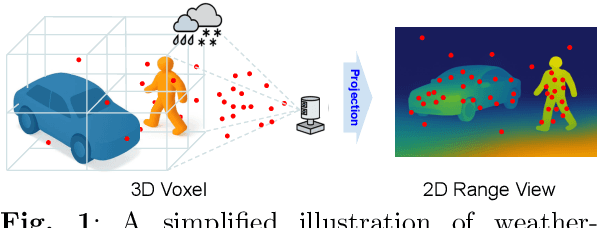
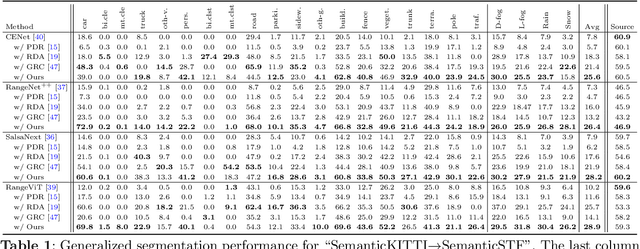
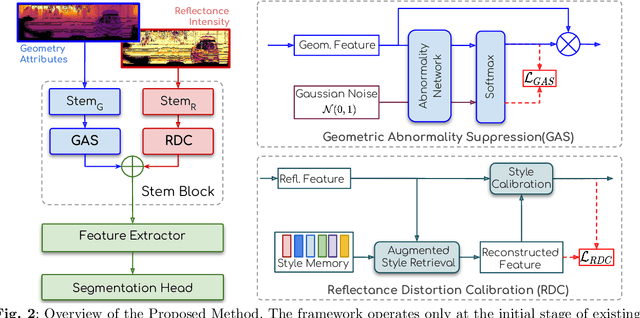
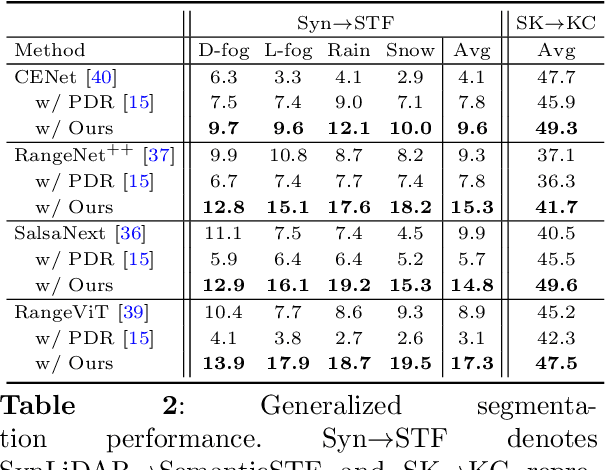
Abstract:LiDAR segmentation has emerged as an important task to enrich multimedia experiences and analysis. Range-view-based methods have gained popularity due to their high computational efficiency and compatibility with real-time deployment. However, their generalized performance under adverse weather conditions remains underexplored, limiting their reliability in real-world environments. In this work, we identify and analyze the unique challenges that affect the generalization of range-view LiDAR segmentation in severe weather. To address these challenges, we propose a modular and lightweight framework that enhances robustness without altering the core architecture of existing models. Our method reformulates the initial stem block of standard range-view networks into two branches to process geometric attributes and reflectance intensity separately. Specifically, a Geometric Abnormality Suppression (GAS) module reduces the influence of weather-induced spatial noise, and a Reflectance Distortion Calibration (RDC) module corrects reflectance distortions through memory-guided adaptive instance normalization. The processed features are then fused and passed to the original segmentation pipeline. Extensive experiments on different benchmarks and baseline models demonstrate that our approach significantly improves generalization to adverse weather with minimal inference overhead, offering a practical and effective solution for real-world LiDAR segmentation.
The Final Layer Holds the Key: A Unified and Efficient GNN Calibration Framework
May 16, 2025Abstract:Graph Neural Networks (GNNs) have demonstrated remarkable effectiveness on graph-based tasks. However, their predictive confidence is often miscalibrated, typically exhibiting under-confidence, which harms the reliability of their decisions. Existing calibration methods for GNNs normally introduce additional calibration components, which fail to capture the intrinsic relationship between the model and the prediction confidence, resulting in limited theoretical guarantees and increased computational overhead. To address this issue, we propose a simple yet efficient graph calibration method. We establish a unified theoretical framework revealing that model confidence is jointly governed by class-centroid-level and node-level calibration at the final layer. Based on this insight, we theoretically show that reducing the weight decay of the final-layer parameters alleviates GNN under-confidence by acting on the class-centroid level, while node-level calibration acts as a finer-grained complement to class-centroid level calibration, which encourages each test node to be closer to its predicted class centroid at the final-layer representations. Extensive experiments validate the superiority of our method.
SConU: Selective Conformal Uncertainty in Large Language Models
Apr 19, 2025Abstract:As large language models are increasingly utilized in real-world applications, guarantees of task-specific metrics are essential for their reliable deployment. Previous studies have introduced various criteria of conformal uncertainty grounded in split conformal prediction, which offer user-specified correctness coverage. However, existing frameworks often fail to identify uncertainty data outliers that violate the exchangeability assumption, leading to unbounded miscoverage rates and unactionable prediction sets. In this paper, we propose a novel approach termed Selective Conformal Uncertainty (SConU), which, for the first time, implements significance tests, by developing two conformal p-values that are instrumental in determining whether a given sample deviates from the uncertainty distribution of the calibration set at a specific manageable risk level. Our approach not only facilitates rigorous management of miscoverage rates across both single-domain and interdisciplinary contexts, but also enhances the efficiency of predictions. Furthermore, we comprehensively analyze the components of the conformal procedures, aiming to approximate conditional coverage, particularly in high-stakes question-answering tasks.
Can LLMs Interpret and Leverage Structured Linguistic Representations? A Case Study with AMRs
Apr 07, 2025Abstract:This paper evaluates the ability of Large Language Models (LLMs) to leverage contextual information in the form of structured linguistic representations. Specifically, we examine the impact of encoding both short and long contexts using Abstract Meaning Representation (AMR) structures across a diverse set of language tasks. We perform our analysis using 8-bit quantized and instruction-tuned versions of Llama 3.1 (8B), Phi-3, and Mistral 7B. Our results indicate that, for tasks involving short contexts, augmenting the prompt with the AMR of the original language context often degrades the performance of the underlying LLM. However, for tasks that involve long contexts, such as dialogue summarization in the SAMSum dataset, this enhancement improves LLM performance, for example, by increasing the zero-shot cosine similarity score of Llama 3.1 from 66.2% to 76%. This improvement is more evident in the newer and larger LLMs, but does not extend to the older or smaller ones. In addition, we observe that LLMs can effectively reconstruct the original text from a linearized AMR, achieving a cosine similarity of 81.3% in the best-case scenario.
TruthPrInt: Mitigating LVLM Object Hallucination Via Latent Truthful-Guided Pre-Intervention
Mar 13, 2025Abstract:Object Hallucination (OH) has been acknowledged as one of the major trustworthy challenges in Large Vision-Language Models (LVLMs). Recent advancements in Large Language Models (LLMs) indicate that internal states, such as hidden states, encode the "overall truthfulness" of generated responses. However, it remains under-explored how internal states in LVLMs function and whether they could serve as "per-token" hallucination indicators, which is essential for mitigating OH. In this paper, we first conduct an in-depth exploration of LVLM internal states in relation to OH issues and discover that (1) LVLM internal states are high-specificity per-token indicators of hallucination behaviors. Moreover, (2) different LVLMs encode universal patterns of hallucinations in common latent subspaces, indicating that there exist "generic truthful directions" shared by various LVLMs. Based on these discoveries, we propose Truthful-Guided Pre-Intervention (TruthPrInt) that first learns the truthful direction of LVLM decoding and then applies truthful-guided inference-time intervention during LVLM decoding. We further propose ComnHallu to enhance both cross-LVLM and cross-data hallucination detection transferability by constructing and aligning hallucination latent subspaces. We evaluate TruthPrInt in extensive experimental settings, including in-domain and out-of-domain scenarios, over popular LVLMs and OH benchmarks. Experimental results indicate that TruthPrInt significantly outperforms state-of-the-art methods. Codes will be available at https://github.com/jinhaoduan/TruthPrInt.
Robust Multi-View Learning via Representation Fusion of Sample-Level Attention and Alignment of Simulated Perturbation
Mar 06, 2025



Abstract:Recently, multi-view learning (MVL) has garnered significant attention due to its ability to fuse discriminative information from multiple views. However, real-world multi-view datasets are often heterogeneous and imperfect, which usually makes MVL methods designed for specific combinations of views lack application potential and limits their effectiveness. To address this issue, we propose a novel robust MVL method (namely RML) with simultaneous representation fusion and alignment. Specifically, we introduce a simple yet effective multi-view transformer fusion network where we transform heterogeneous multi-view data into homogeneous word embeddings, and then integrate multiple views by the sample-level attention mechanism to obtain a fused representation. Furthermore, we propose a simulated perturbation based multi-view contrastive learning framework that dynamically generates the noise and unusable perturbations for simulating imperfect data conditions. The simulated noisy and unusable data obtain two distinct fused representations, and we utilize contrastive learning to align them for learning discriminative and robust representations. Our RML is self-supervised and can also be applied for downstream tasks as a regularization. In experiments, we employ it in unsupervised multi-view clustering, noise-label classification, and as a plug-and-play module for cross-modal hashing retrieval. Extensive comparison experiments and ablation studies validate the effectiveness of RML.
Navigating Semantic Drift in Task-Agnostic Class-Incremental Learning
Feb 11, 2025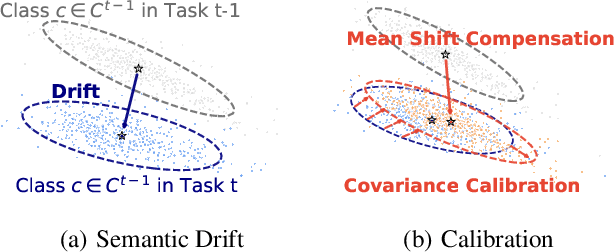
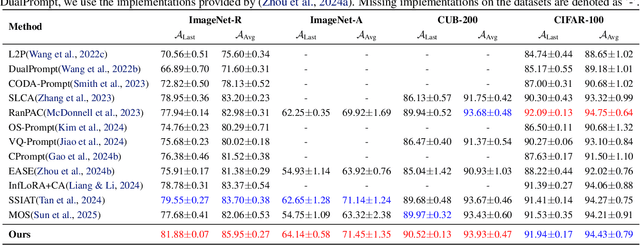
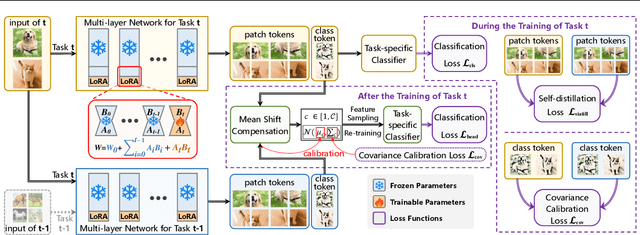
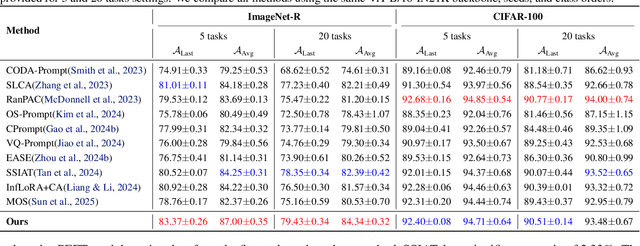
Abstract:Class-incremental learning (CIL) seeks to enable a model to sequentially learn new classes while retaining knowledge of previously learned ones. Balancing flexibility and stability remains a significant challenge, particularly when the task ID is unknown. To address this, our study reveals that the gap in feature distribution between novel and existing tasks is primarily driven by differences in mean and covariance moments. Building on this insight, we propose a novel semantic drift calibration method that incorporates mean shift compensation and covariance calibration. Specifically, we calculate each class's mean by averaging its sample embeddings and estimate task shifts using weighted embedding changes based on their proximity to the previous mean, effectively capturing mean shifts for all learned classes with each new task. We also apply Mahalanobis distance constraint for covariance calibration, aligning class-specific embedding covariances between old and current networks to mitigate the covariance shift. Additionally, we integrate a feature-level self-distillation approach to enhance generalization. Comprehensive experiments on commonly used datasets demonstrate the effectiveness of our approach. The source code is available at \href{https://github.com/fwu11/MACIL.git}{https://github.com/fwu11/MACIL.git}.
Rethinking Chain-of-Thought from the Perspective of Self-Training
Dec 14, 2024Abstract:Chain-of-thought (CoT) reasoning has emerged as an effective approach for activating latent capabilities in large language models (LLMs). We observe that CoT shares significant similarities with self-training in terms of their learning processes. Motivated by these parallels, this paper explores the underlying relationship between CoT and self-training, demonstrating how insights from self-training can enhance CoT performance. Specifically, our study first reveals that CoT, like self-training, follows the principle of semantic entropy minimization. Leveraging this insight, we propose a novel CoT framework that incorporates two key components: (i) a task-specific prompt module designed to guide LLMs in generating high-quality initial reasoning processes, and (ii) an adaptive reasoning iteration module for progressively refining the reasoning process.
 Add to Chrome
Add to Chrome Add to Firefox
Add to Firefox Add to Edge
Add to Edge